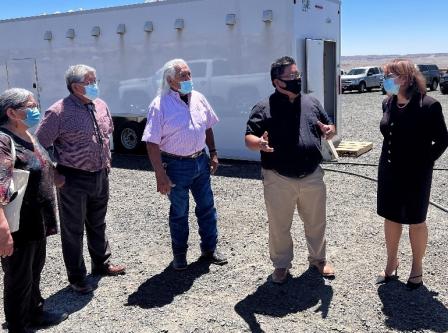
Archived Content
This site contains information that has been considered archived and will no longer be updated.
EDA Celebrates National Native American Heritage Month
More than 20 years ago, Harlan Majors, the mayor of Philadelphia, Mississippi, observed that “our best industry by far is the Choctaw Nation. They employ not only their own people but ours, too. It has never been as good as it is now ... Our economy depends on them.”
Not just in Mississippi, but throughout the United States, Tribes, Tribal businesses, and Indigenous-owned enterprises are reasserting themselves as major drivers of the American economic engine. But the commercial success enjoyed by many Tribal nations and Alaskan Native Villages conceals a major contradiction in Indigenous economies that is underscored by shortcomings in individual economic empowerment. According to data from the U.S. Census Bureau’s American Community Survey, one in three Native Americans are living in poverty. Research suggests that “distinct institutional and policy features of Native labor markets create unique challenges that impact Indian well-being.” Specifically, the distance between Tribal labor markets and major economic centers acts as a systemic impediment to the availability of good-paying jobs in Indian Country.1
During the month of November, the U.S. Economic Development Administration (EDA) joins other Department of Commerce bureaus in celebrating National Native American Heritage Month. EDA is committed to ensuring the promise of American prosperity is equitably realized through strategic investments in projects and initiatives designed to overcome systemic inequities and create good-paying jobs in the United States’ Native American and Alaskan Native communities.

Recent EDA initiatives include:
Assistant Secretary of Commerce for Economic Development Alejandra Y. Castillo (right) consults with economic development leaders of the Hopi Tribe during a June 2022 visit.
- Through President Biden’s American Rescue Plan (ARPA), EDA recently completed distribution of $100 million in funding through the Indigenous Communities program, a major investment initiative created to support Tribal governments, and related organizations, as they design and execute economic development projects to recover from the pandemic and build economies for the future.
- Beyond the Indigenous Communities program, more than $400 million in additional EDA funding has flowed to Native American and Alaskan Native communities over the last 18 months. Examples of these investments include an $875,079 grant to Laguna Economic Advancement, LLC, Laguna, New Mexico, to develop a master plan and design for a facility to house Tribal businesses along the Route 66 tourism corridor; a $5 million grant to the Yurok Tribe, Klamath, California, to support establishment of an aerial imaging enterprise; and a $3.2 million grant to Elk Valley Rancheria, Crescent City, California, to support a new, Tribally-owned enterprise.
- EDA has also recommitted its efforts to ensure indigenous perspectives are incorporated into the bureau’s decision-making. Recently, senior EDA leadership conducted in-person consultations with Tribal economic development leaders in Alaska, Arizona, and South Dakota.
- Last year, the bureau hired its first Tribal specific Economic Development Representative to focus on the unique economic needs of Indian Country.
- In September 2021, EDA updated its regulations to make funding more accessible to Tribal nations, extending eligibility to include for-profit entities that are wholly owned by and established for the benefit of a Tribe and its members.
“The numerous achievements of Pre-Colombian Native American communities include major advancements in commerce and agriculture,” said Assistant Secretary of Commerce for Economic Development Alejandra Y. Castillo. “Today we pay tribute to that legacy by recommitting ourselves to meaningful and collaborative work with each of the United States’ 574 federally recognized Tribes.”
Follow EDA on Twitter, Facebook, Instagram, and LinkedIn throughout November for updates on EDA observances and activities in celebration of National Native American Heritage Month. For ongoing news related to the Economic Development Administration’s investments in Tribal communities, subscribe to Indigenous Intel, EDA’s Indigenous-focused newsletter.
1. Redbird, B. (n.d.). (rep.). Islands of Labor: Reservation Labor Markets and American Indian Well-Being. Retrieved October 19, 2022, from https://www.dol.gov/sites/dolgov/files/OASP/legacy/files/Islands-of-Labor-D4.pdf.
